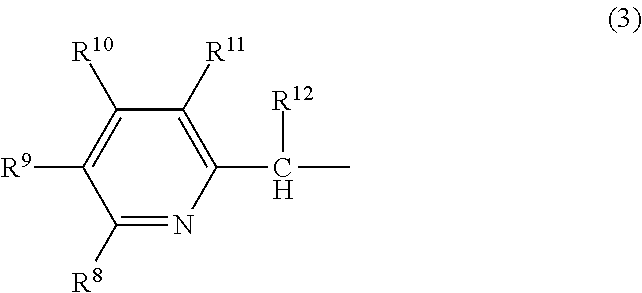Manufacturing method of (METH) acrylic polymer
- Summary
- Abstract
- Description
- Claims
- Application Information
AI Technical Summary
Benefits of technology
Problems solved by technology
Method used
Image
Examples
example 1
[0126]100 parts of n-butyl acrylate, 80 parts by volume of methanol (MeOH), 1.76 parts of diethyl 2,5-dibromoadipate and 955 ppm of N,N,N′N′-pentamethyldiethylenetriamine (PMDETA) were introduced and stirred at 55° C. in the presence of flowing nitrogen. A solution obtained by dissolving 107 ppm of copper (Ii) bromide (CuBr2) (copper content: 30 ppm) in 109 ppm (equimolar amount relative to Cu) of hexamethyltris(2-aminoethyl)amine (Me6TREN) having a purity of 96% and 0.54 parts by volume of N,N-dimethylacetoamide, and a solution obtained by dissolving 17 ppm of ascorbic acid (VC) in 0.12 parts by volume of methanol, were separately prepared, and then added to the mixture to start the reaction. Heating and stirring were continued in such a manner that the temperature of the reaction solution was 50° C. to 60° C., during which the solution obtained by dissolving ascorbic acid in methanol was appropriately added along the way. Once the reaction rate of n-butyl acrylate reached 92 mol %...
example 2
[0127]100 parts of n-butyl acrylate, 80 parts by volume of methanol, 1.76 parts of diethyl 2,5-dibromoadipate and 955 ppm of triethylamine (Et3N) were introduced and stirred at 45° C. in the presence of flowing nitrogen. A solution obtained by dissolving 107 ppm of copper (II) bromide (copper content: 30 ppm) in 109 ppm (equimolar amount relative to Cu) of hexamethyltris(2-aminoethyl)amine having a purity of 96% and 0.54 parts by volume of N,N-dimethylacetoamide, and a solution obtained by dissolving 17 ppm of ascorbic acid in 0.13 parts by volume of methanol, were separately prepared, and then added to the mixture to start the reaction. Heating and stirring were continued in such a manner that the temperature of the reaction solution was 45° C. to 60° C., during which the solution obtained by dissolving ascorbic acid in methanol was appropriately added along the way. Once the reaction rate of n-butyl acrylate reached 94 mol % at 153 minutes after the start of polymerization, the pr...
example 3
[0128]100 parts of n-butyl acrylate, 80 parts by volume of methanol, 1.76 parts of diethyl 2,5-dibromoadipate and 955 ppm of triethylamine were introduced and stirred at 45° C. in the presence of flowing nitrogen. A solution obtained by dissolving 53 ppm of copper (II) bromide (copper content: 15 ppm) in 54 ppm (equimolar amount relative to Cu) of hexamethyltris(2-aminoethyl)amine having a purity of 96% and 0.27 parts by volume of N,N-dimethylacetoamide, and a solution obtained by dissolving 17 ppm of ascorbic acid in 0.13 parts by volume of methanol, were separately prepared, and then added to the mixture to start the reaction. Heating and stirring were continued in such a manner that the temperature of the reaction solution was 45° C. to 60° C., during which the solution obtained by dissolving ascorbic acid in methanol was appropriately added along the way. Once the reaction rate of n-butyl acrylate reached 94 mol % at 175 minutes after the start of polymerization, the pressure in...
PUM
| Property | Measurement | Unit |
|---|---|---|
| Fraction | aaaaa | aaaaa |
| Percent by mass | aaaaa | aaaaa |
| Fraction | aaaaa | aaaaa |
Abstract
Description
Claims
Application Information
 Login to View More
Login to View More - R&D
- Intellectual Property
- Life Sciences
- Materials
- Tech Scout
- Unparalleled Data Quality
- Higher Quality Content
- 60% Fewer Hallucinations
Browse by: Latest US Patents, China's latest patents, Technical Efficacy Thesaurus, Application Domain, Technology Topic, Popular Technical Reports.
© 2025 PatSnap. All rights reserved.Legal|Privacy policy|Modern Slavery Act Transparency Statement|Sitemap|About US| Contact US: help@patsnap.com



